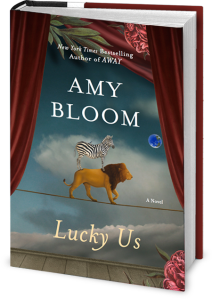Book Review: Family Portrait
 Commentary on Lucky Us by Amy Bloom
Commentary on Lucky Us by Amy Bloom
How
do we define family? Is it a term describing merely our blood
relations, a menagerie of characters, some of whom we have never met,
never mind ever gotten to know? Or is family a group of sympathetic
souls, related or not, whose lives have intertwined over the years,
either by free will or luck: a group whom we can depend on, live with,
and love? These are some of the questions evoked by Amy Bloom's latest
novel Lucky Us, which follows a family, some related by blood,
through crucially volatile times, both for the world in the twentieth
century (the pre- through post-World War II years) as well as for
Bloom's main characters.
Eva
and Iris are half sisters, borne of the same college professor father,
Edgar, through whom they are inexorably linked. They first meet in their
teens-- Eva twelve, Iris sixteen-- after Iris's mother dies and Eva's
own mom abandons her at their father's home in Ohio. Eva is the
bookworm, Iris the drama queen-- literally; she regularly wins prizes
for speech recitals. From the start, it's clear that Eva is to be Iris's
little helper. She "looked at me the way a cat looks at a dog" and
"talked to me the way Claudette Colbert talked to Louise Beavers in Imitation of Life..." says
Eva of her new-found semi-sibling. In time the two manage to gain each
other's trust but the dynamic of their relationship changes very little.
When
the duo decide to run away to Hollywood, Eva forgoes her education and
learns how to cook so that Iris can gain fame as an actress. After a
photographer exposes Iris's illicit affair with another actress, all the
sacrifice and support in the world couldn't save the up-and-comer from
the likes of a vicious gossip columnist like Hedda Hopper.
But just as the sisters are ready to hit skid row, lucky them, Daddy
Edgar shows up. He's now a retired college professor with no money.
However Iris's good friend and make-up artist Francisco has a plan for
the crew: he's moving near his hair-styling sisters', Carnie and Bea, in
New York to start a business and they've heard tell of an opening for a
butler and a governess at a large estate out on Long Island; just
perfect for Edgar and Iris to fill. Bloom's tale pivots and drives
straight for the East Coast.
Through
the use of literary devices like letters, changing voice, and alternate
points of view, Bloom deepens her story of the rag-tag clan. As Eva
carves out a niche for herself at Bea and Carnie's beauty shop reading
Tarot cards-- telling people what they want to hear-- love continues to
be the dominant impetus for Iris. In fact she's willing to sacrifice
other people's lives in the pursuit of her own happiness. She informs on
Gus, the German-American husband of love interest, Reenie-the-cook.
Apparently poor Gus is in Iris's way, and as it turns out, there are
brand new camps opening up across America just perfect for guys like
Gus. But when catastrophe alters her renovated love nest, Iris hits the
road once again; this time to England where she revives her acting
career. It falls to Eva to mop up after her sister's mess. There she
goes once more, sacrificing her happiness for the people who have become
her family.
There's that word again: family.
As Eva's grows larger, with the addition of Clara, Edgar's singing
sweetheart, and Danny, a moppet whom Eva liberates from the local
orphanage, Bloom redefines the Us in Lucky Us. Primarily
through the characters of Edgar and Gus she slyly fogs the Old-World
focus of nationality, religion, race, and class. The pervading subtext
questions how we define ourselves; are we Black, White, Rich, Poor,
German, Jewish, Homosexual, etc...? Are we rooted and predestined or can
we slip the taxonomic bonds and simply call ourselves human; having what Philip Roth called the Human Stain?
For all the inequity, unfairness, discrimination, and misfortune Bloom evinces in Lucky Us, she
manages to convey a feeling of optimism throughout, of hope for not
only a better life for her characters but for an improved post World War
society; or for at least a return to normalcy. There is a message of
forgiveness and acceptance that pervades this novel and it is
contagious. It spreads from one cobbled family member to the next until
eventually all the souls that are drawn together, that congregate for a
definitive final portrait can truly say they care for each other.
Rating: 4.0 Stars
Rating: 4.0 Stars
© 2014 by Michael Jones

Comments
Post a Comment